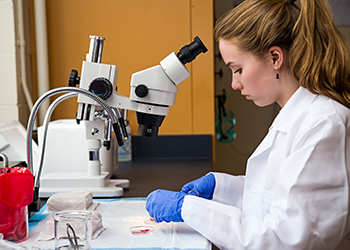Dr. Robert Peoples' Research
Most of the fast communication among the neurons of the central nervous system is mediated by a class of proteins known as neurotransmitter-gated ion channels. One of these proteins, the N-methyl-d-aspartate (NMDA) glutamate receptor-ion channel, plays essential roles in cognition, motor function, sensory processing, and learning, and is considered to be a primary target of alcohol action in the brain.
Research in my laboratory has focused on defining the molecular mechanisms and sites of action of alcohols and other CNS depressants on the NMDA receptor. This has involved investigation of the specific sites and precise molecular mechanisms by which alcohols and related agents interact with NMDA receptors. Because these sites appear to be located in the membrane-associated domains of these receptors, this research has also involved characterizing the structure and function of these regions.
Research in my laboratory has also included investigation of novel mechanisms of intracellular regulation of receptors activated by the inhibitory amino acid glycine, the alcohol sensitivity of purinergic receptors activated by extracellular ATP, and the relation between binding and ion channel gating in 5-HT3 serotonin receptors.
Dr. Peoples research highlighted in International Innovation
Selected Publications
- Ren, H., Zhao, Y., Wu, M., and Peoples, R.W.: A Novel Alcohol-Sensitive Position in the NMDA Receptor GluN2A Subunit M3 Domain Regulates Agonist Affinity and Ion Channel Gating. Mol. Pharmacol. 84: 501-510, 2013.
- Li, C.Y., Xiong, K.M., Wu, Y.X., Liu, Y.W., Chen, L., Stewart, R.R., Peoples, R.W., Yi, C.L.: Conserved extracellular cysteines differentially regulate the potentiation produced by Zn2+ in rat P2X4 receptors. Eur. J. Pharmacol. 707: 11-16, 2013.
- Ren, H., Zhao, Y., Dwyer, D.S., and Peoples, R.W.: Interactions among positions in the third and fourth membrane-associated domains at the intersubunit interface of the N-methyl-D-aspartate receptor forming sites of alcohol action. J. Biol. Chem. 287: 27302-27312, 2012.
- Moraga-Cid, G., Yevenes, G.E., Figueroa, M., Bunster, M., Schmalzing, G., Peoples, R.W., and Aguayo, L.G.: A single phenylalanine residue in the main intracellular loop of a1 g-aminobutyric acid type A and glycine receptors influences their sensitivity to propofol. Anesthesiol. 115: 464 – 473, 2011.
- Yevenes, G., Moraga-Cid, G., Avila, A., Guzman, L., Figueroa, M., Peoples, R.W., and Aguayo, L.G.: Molecular requirements for ethanol differential allosteric modulation of ligand-gated ion channels based on selective Gβγ modulation. J. Biol. Chem. 285: 30203 - 30213; 2010.
- Salous, A., Ren, H., Lamb, K.A., Hu, X.-Q., Lipsky, R.H., and Peoples, R.W.: Differential actions of ethanol and trichloroethanol at sites in the M3 and M4 domains of the NMDA receptor NR2A subunit. Brit. J. Pharmacol. 158: 1395 – 1404, 2009.
- Yevenes, G.E., Moraga-Cid,G., Peoples, R.W., Schmalzing, G., and Aguayo, L.G.: A selective Gbg-linked intracellular mechanism for modulation of a ligand-gated ion channel by ethanol. Proc. Natl. Acad. Sci. USA 105: 20523-20528, 2008.
- Ren, H., Salous, A.K., Paul, J.M., Lamb, K.A., Dwyer, D.S., and Peoples, R.W.: Functional interactions of alcohol-sensitive sites in the NMDA receptor M3 and M4 domains. J. Biol. Chem. 283: 8250-8257, 2008.
- Hu, X.-Q., and Peoples, R.W.: The 5-HT3B subunit confers spontaneous channel opening and altered ligand properties of the 5-HT3 receptor. J. Biol. Chem. 283: 6826-68231, 2008.
- Sun, H., Hu, X., Emerit, M.B., Schoenebeck, J.C., Kimmel, C.E., Peoples, R.W., Miko, A., and Zhang, L.: Modulation of 5-HT3 receptor distribution by the light chain of MAP1B expressed in HEK 293 cells. J. Physiol. 586: 751-762, 2008.
- Hu, X.-Q., and Peoples, R.W.: Arginine 246 in the pre-transmembrane domain 1 region alters 2,2,2-trichloroethanol action in the 5-HT3A receptor. J. Pharmacol. Exp. Ther. 324: 1011-1018, 2008.
- Ren, H., Salous, A.K., Paul, J.M., Lipsky, R.H., and Peoples, R.W.: Mutations at F637 in the NMDA receptor NR2A subunit M3 domain influence agonist potency, ion channel gating, and alcohol action. Br. J. Pharmacol. 151: 749-57, 2007.
- Honse, Y., Ren, H., Lipsky, R.H., and Peoples, R.W.: Sites in the fourth membrane-associated domain regulate alcohol sensitivity of the NMDA receptor. Neuropharmacol. 46: 647-654, 2004.
- Ren, H., Honse, Y., and Peoples, R.W.: A site of alcohol action in the fourth membrane-associated domain of the n-methyl-d-aspartate receptor. J. Biol. Chem. 278: 48815-48820, 2003.Yevenes, G.E., Peoples, R.W., Tapia, J.C., Parodi, J., Soto, X., Olate, J., and Aguayo, L.G.: Modulation of glycine-activated ion channel function by G protein bg subunits. Nat. Neurosci. 6: 819-824, 2003.


